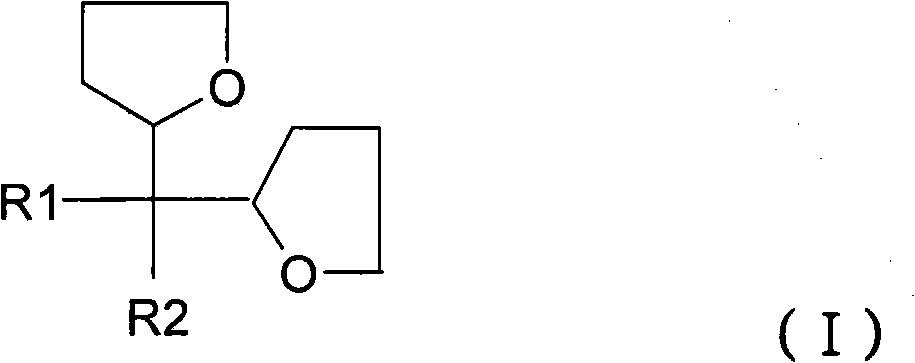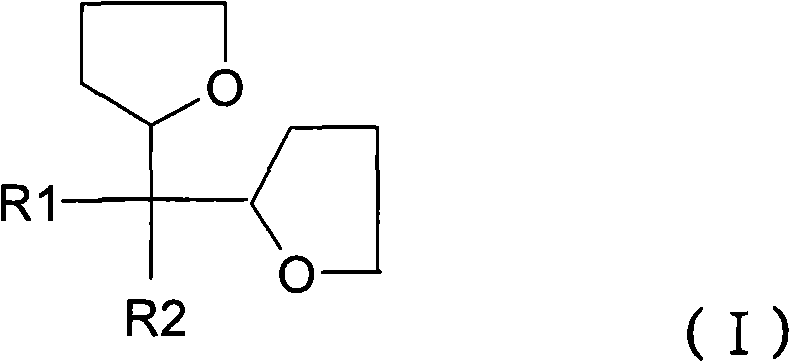Terpolymer rubber with medium/high side group content and preparation method and applications thereof
A vinyl aromatic hydrocarbon terpolymer and terpolymer technology, applied in the field of new terpolymer rubber, can solve problems such as strong, pungent odor, environmental protection and insufficient safety in the operating environment
- Summary
- Abstract
- Description
- Claims
- Application Information
AI Technical Summary
Problems solved by technology
Method used
Image
Examples
Embodiment 1
[0055]Under the protection of high-purity nitrogen, mixed solvent (mixture of cyclohexane and n-hexane: 82 / 18, mass ratio), styrene (ST), isoprene (IP), butadiene ( BD) and double tetrahydrofurfuryl propane (DTHFP) were added to a 5 liter stainless steel polymerization reactor with stirring. The temperature of the reactor was raised to 40°C by heating the jacket with hot water, the polymerization pressure was controlled between 0.1MPa-0.3MPa, and n-butyl lithium was added to initiate the reaction. After 60 minutes of polymerization, tin tetrachloride was added for coupling for 30 minutes. Then add isopropanol which is 1.2 times (molar ratio) of n-butyllithium to terminate the reaction, and condense with water vapor to obtain a random ternary copolymer rubber product. The microstructure and properties of the product are shown in Table 1.
Embodiment 2-4
[0057] According to the procedure described in Example 1, the difference is that the polymerization initiation temperature is 50°C, 60°C, and 70°C, respectively, and the microstructure and various properties of the product are shown in Table 1.
[0058] Table 1 Product Microstructure and Various Properties
[0059] project Example 1 Example 2 Example 3 Example 4 Solvent / g 2288 2288 2288 2288 ST / g 62.4 62.4 62.4 62.4 BD / g 124.8 124.8 187.2 187.2 IP / g 124.8 124.8 62.4 62.4 DTHFP / Li (molar ratio) 0.5 0.5 0.5 0.5 Polymerization initiation temperature / °C 40 50 60 70 Molecular weight, M 峰值 (Ten thousand) 18.2 21.9 16.8 15.8 Molecular weight distribution, MWD 1.533 1.596 1.572 1.651 Coupling efficiency / % 63.7 62.0 61.5 42.0 Gum Mooney 64 70 53 43 Compound Mooney Viscosity 89 102 94 9...
Embodiment 5-11
[0061] Carry out according to the procedure described in Example 2, the difference is to adjust the structure regulator dose added to the polymerization system, so that the proportioning ratio with organic lithium becomes 0.1, 0.2, 0.4, 0.6, 0.7, 1.0, 2.0, the product The microstructure and various properties are shown in Table 2 below.
[0062] Table 2 Product Microstructure and Various Properties
[0063] project Example 5 Example 6 Example 7 Example 8 Example 9 Example 10 Example 11 Solvent / g 2288 2288 2288 2288 2288 2288 2288 ST / g 62.4 62.4 62.4 62.4 62.4 62.4 62.4 BD / g 124.8 124.8 124.8 124.8 124.8 124.8 124.8 IP / g 124.8 124.8 124.8 124.8 124.8 124.8 124.8 DTHFP / Li (molar ratio) 0.1 0.2 0.4 0.6 0.7 1.0 2.0 Polymerization initiation temperature ℃ 50 50 50 50 50 50 50 Molecular weight, M 峰值 (...
PUM
| Property | Measurement | Unit |
|---|---|---|
| coupling rate | aaaaa | aaaaa |
| Functional group degree | aaaaa | aaaaa |
Abstract
Description
Claims
Application Information
 Login to View More
Login to View More - R&D
- Intellectual Property
- Life Sciences
- Materials
- Tech Scout
- Unparalleled Data Quality
- Higher Quality Content
- 60% Fewer Hallucinations
Browse by: Latest US Patents, China's latest patents, Technical Efficacy Thesaurus, Application Domain, Technology Topic, Popular Technical Reports.
© 2025 PatSnap. All rights reserved.Legal|Privacy policy|Modern Slavery Act Transparency Statement|Sitemap|About US| Contact US: help@patsnap.com


